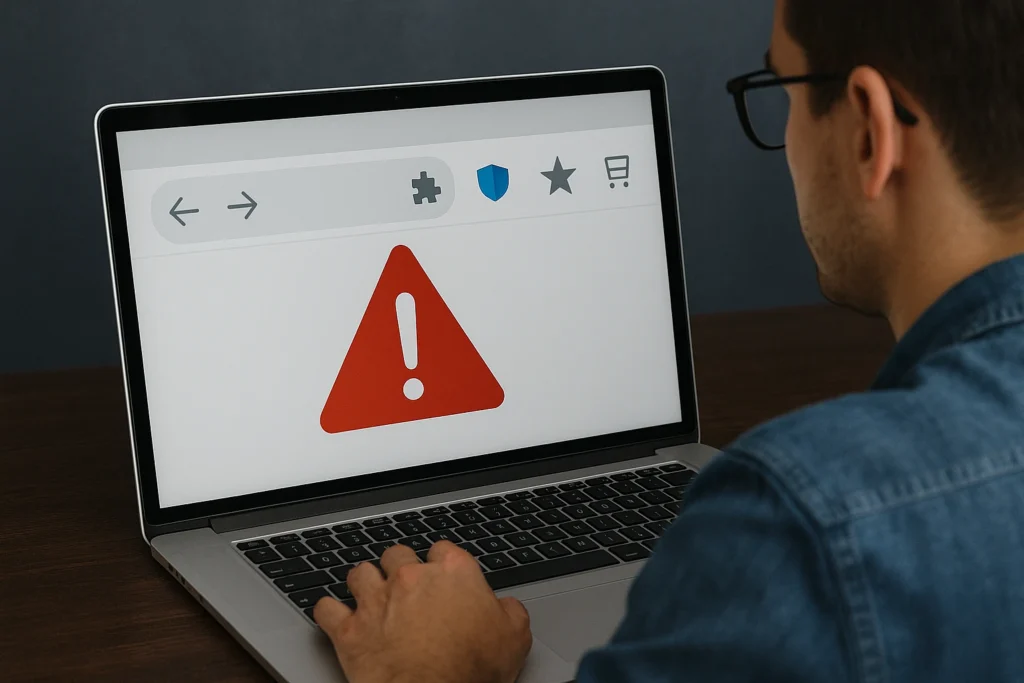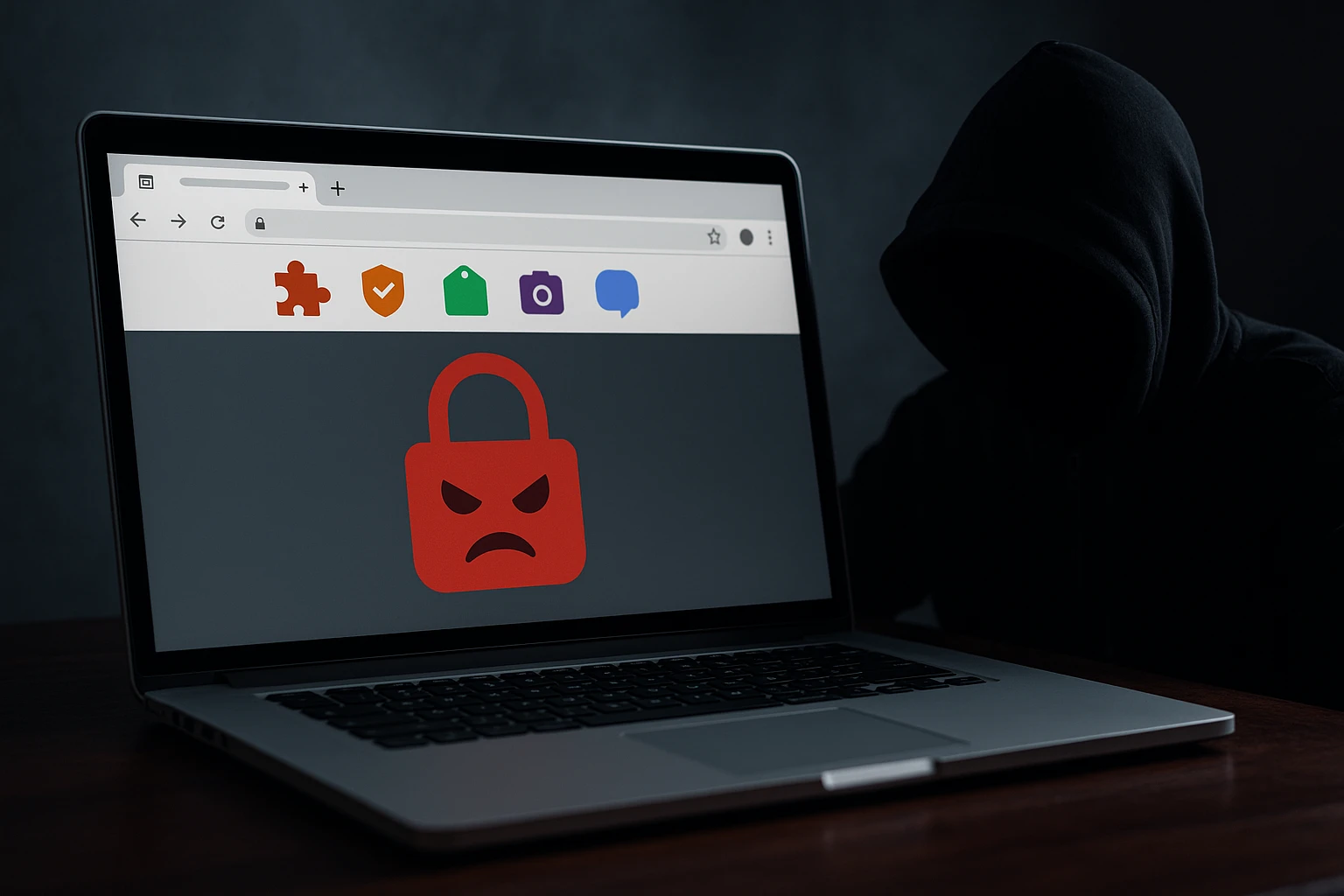You trust your browser, right? But have you ever stopped to think about what’s hiding inside it? According to a recent report, 99% of enterprise users have at least one browser extension installed, and over half of those extensions are rated as high or critical risk. That’s a serious blind spot in browser security, and most people don’t even realise they’re leaving the door wide open.
While you may think that these small tools are limited to tweaking your tabs or fixing your grammar, some malicious browser extensions can spy on what you type, steal sensitive data, or get into enterprise systems without anyone noticing.
In this post, we’ll walk you through how these threats work, what’s really at risk, and how to protect yourself and your business before anything slips through.
Let’s get started!
What Makes Browser Extensions Risky?
Browser extensions are small software tools added to browsers to enhance functionality, such as blocking ads or managing passwords. Some extensions are poorly built or intentionally malicious. These risky extensions can access everything you do online, including passwords, emails and company data.
Once you install those shady extensions, they might track your activity, inject harmful scripts or even steal sensitive information. That makes them a hidden but serious threat to your computer’s overall security.

Let’s break down how they work and why they’re a favourite tool for cybercriminals:
- Extensions often ask for broad permissions
Extensions need access to your browser to function, but some go too far. When an extension asks to “read and change all your data on websites you visit,” that’s like giving a stranger the keys to your postbox, and hoping they won’t open your mail. - Extensions are rarely reviewed closely
Unlike apps in a mobile store, most extensions go live with close to no supervision. Threat actors love this because they can push updates or hide code without much inspection. - Extensions collect more than you think
Some malicious browser extensions track your keystrokes, inject ads into pages, or monitor what sites you visit. If you’re noticing odd pop-ups or your browser feels strange, this might be the reason why it’s happening. - Extensions mimic trusted tools
It’s common for bad actors to copy popular productivity tools. These fake versions often use similar logos or names, making them hard to spot. Always check the developer’s name, reviews, and update history before installing anything.
Pro Tip: Search for the extension’s name on trusted forums or Reddit before downloading. If something feels off, it probably is.
Case Studies That Should Worry You
If the last section made browser extensions sound risky in theory, this one will show you how that risk plays out in real life. These are events that have already happened. Big ones. And the consequences hit both individuals and enterprises hard.
So if you’re still on the fence about the role browser extensions play in enterprise cybersecurity, let’s cover some cybersecurity case studies that illustrate the dangers of them.
The DataSpii Breach: A Closer Look
This breach came to light in 2019, exposing sensitive information from users at major companies including Apple, Tesla and Blue Origin. The culprit? A handful of Chrome and Firefox extensions which were collecting browsing data and sending it off to a data monetisation firm.
Timeline Snapshot:
- Early 2018: Data collection quietly begins
- Mid-2019: Researchers expose the activity
- Impact: Over 4 million users affected, including enterprise data leaks
Do you know what the worst part was? Users thought these were simple tools like PDF converters and coupon finders. And then they were hit hard with the news of what actually happened there.
Google’s Massive Extension Purge
In early 2020, Google removed more than 500 Chrome extensions after discovering they were secretly exfiltrating data. Many extensions had been available for years and had millions of downloads combined.
This incident revealed how slow detection can be, and how high the stakes are.
Hijacked Tools: When Good Turns Bad
Some of the most dangerous extensions start out completely legitimate. “Particle for YouTube” is a perfect example. It began as a helpful tool for customising the YouTube experience, trusted by thousands of users.
But after it was quietly sold to a new developer, the extension was updated to include malicious code that injected ads into pages and tracked browsing behaviour without permission. Because users had already installed it and trusted it, the update went unnoticed until the damage was done.
What Could Users Have Done?
A few simple habits can go a long way in spotting trouble before it starts and keeping your browser security intact.
Here’s what would have helped in the case of Particle for YouTube and others like it:
- Monitor update logs. Most browser extension stores have a “Version History” or “Updates” tab where you can see what changes were made. Watching for sudden permission increases or vague update notes can help you catch suspicious behaviour early.
- Read recent reviews. Scroll to the newest reviews in the extension store and look for comments about unexpected changes, bugs or intrusive ads. This can alert you to problems other users are already experiencing before you do.
- Remove tools if the original developer leaves without explanation. Check the developer name listed on the extension and see if it’s changed or if the site link stopped working. If ownership changes with no official notice, it’s safest to uninstall before risky updates appear.
These examples serve as warnings for potential users that teach a valuable lesson. The best way to protect your browser security is to learn from the hits others have already taken.
Common Misconceptions That Get Users in Trouble
You’ve seen how real attacks happen and what users could have done to stop them. Now let’s talk about the thinking that often leaves people exposed.

We think that correcting these thoughts will help your company avoid similar mistakes in the future.
- Myth: “It’s from the Chrome Web Store, it must be safe”
Truth: People trust the Chrome Web Store because they assume everything listed has passed a strict review process. The truth is, Google uses automated checks and doesn’t always catch bad behaviour right away. That is why some harmful extensions stay live for months or even years.
To be safer, always look at the developer’s name, read the permissions, and check recent reviews before installing anything. - Myth: “I only installed one or two, it can’t be a big deal”
Truth: There’s a belief that risk only grows with the number of extensions, but it really only takes one. Jack, a finance consultant from Melbourne, found this out the hard way. He installed a note-taking tool that looked harmless, but a later update added code that recorded every keystroke, including passwords and sensitive company data.
He didn’t suspect a thing until he saw unauthorised transfers on his business account. - Myth: “Extensions can’t access company files, can they?”
Truth: Many users think browser tools are separate from their company’s data, but if you use cloud-based services like Google Workspace or Microsoft 365, your browser is the gateway.
A malicious extension can read what’s on your screen, copy contents from online docs, and even take screenshots. The safest move is to stick with IT-approved tools, avoid unnecessary add-ons, and double-check permission requests during installs.
Why Most Companies Don’t See It Coming
Now that we’ve covered the myths users believe, it’s time to look at the bigger picture. Most threats from malicious browser extensions get in because no one’s looking.
While users might click “Add to Chrome” without thinking, many companies don’t have the systems in place to catch that moment or control what happens next. This is where enterprise cybersecurity often falls short.
Lack of Visibility into Employees’ Browser Habits
Most companies don’t track which extensions their employees install or use. Without visibility, there’s no way to spot risky tools.
Encouraging staff to stay aware of what they’ve added to their browser and providing them with simple checks (like auditing their extensions monthly) can make a big difference.
Shadow IT: Users Installing Unsanctioned Tools
When employees feel limited by the tools they’re given, they often install their own extensions to fill the gap. Companies can reduce this by offering secure, approved alternatives and educating staff on the risks of sidestepping IT protocols.
No Clear Policy or Enforcement Mechanism
The majority of organisations have no formal policy for managing browser extensions. That leaves a wide-open gap in browser security. What’s needed is a focused system called Browser Extension Governance that combines policy, monitoring and training.
In cloud-first workplaces where staff rely on SaaS platforms, this issue is even more urgent. According to a 2023 report by Spin.AI, 75% of SaaS applications come with a great risk to data stored in cloud platforms such as Microsoft 365 and Google Workspace.
How to Spot a Malicious Browser Extension
By now, you’re probably wondering how to tell the good extensions from the bad. It’s not always obvious at first glance, but there are a few clear warning signs you can watch for. These steps will help you stay one step ahead of malicious browser extensions, irrespective of whether you manage your own browser or help others in your team.

Red Flags to Look Out For
The most common red flags to look out for are full access, shady reviews, or no background information. We recommend avoiding these. Here’s more on each one.
- Excessive permissions: If an extension wants access to everything you browse, ask yourself why it needs that. A grammar checker shouldn’t need access to your banking details.
- Poor or vague reviews: If users are reporting bugs, weird pop-ups, or vague concerns, take them seriously.
- Anonymous or suspicious publishers: If the developer has no website, support details or clear background, that’s a red flag.
Tools to Audit Your Extensions
If you’re not sure about an extension, don’t guess. Tools like CRXcavator and Extension Monitor can give you a clearer picture of what an extension does behind the scenes.
- CRXcavator: It scans extensions and highlights risky permissions and behaviour patterns.
- Extension Monitor: It tracks changes in extensions over time, including downloads, popularity changes and version updates.
Manual Checks You Can Do
Manual checks are when you look at the plugin yourself instead of relying on a tool. This is one of the best ways to protect yourself. A few minutes of manual checking can go a long way in protecting your browser security.
- Look at the version history in the extension’s store listing. Sudden updates with unclear descriptions can be a sign of trouble.
- Check what permissions the extension is asking for. If it’s asking for more than it needs to do its job, be cautious.
A Simple 3-Step Audit Process Anyone Can Follow
Even if you’re not in IT, this quick process will help you keep your browser clean and your data safe.
- Step 1: Review
Open your browser’s extension list and scan through everything you’ve installed. Look out for extensions with fishy names like “System Monitor”. Check the permissions you have granted to those extensions. For instance, a grammar checker shouldn’t need access to your browsing history. - Step 2: Research
Google each extension’s name along with terms like “malware” or “data leak.” Also check forums like Reddit for real-user feedback. And visit the developer’s website or GitHub page. Trustworthy developers often have transparent profiles. - Step 3: Remove
Uninstall any extensions you don’t recognise, don’t actively use, or that haven’t been updated in over a year. Verify which extensions haven’t been installed from the official extension stores (Chrome Web Store for Chrome browser, Firefox Add-Ons for the Firefox browser, etc.), and remove them immediately!
Doing this once a month takes less than ten minutes and keeps your browser security in check.
Strategies for Enterprise Defence
If spotting malicious extensions on your own feels like a big job, imagine doing it across an entire company. But businesses can build systems to make browser security easier and more effective.
Creating and Enforcing Browser Extension Policies
Start by listing which extensions are allowed, which are banned, and what permissions are acceptable. Write it up in a simple, clear document and share it with your team.
A policy like this keeps employees informed, gives IT a framework to work from, and helps prevent risky tools from slipping in unnoticed.
Whitelisting vs Blacklisting
Whitelisting means only approved extensions can be installed, and blacklisting blocks specific known threats. Whitelisting gives you tighter control, while blacklisting works best when you’re trying to keep out a short list of problematic tools.
Using Browser Management Tools
Platforms like Chrome Enterprise and Microsoft Edge Policy settings let admins control what users can install, push updates, and block unapproved extensions. These tools are efficient and scale easily across remote teams, making them especially useful for Saas-based workplaces.
Training Employees on Safe Browser Practices
Build short, digestible training sessions around browser safety. Show staff how to check extension permissions and spot suspicious behaviour. A quick refresher every quarter keeps browser security excellent without overwhelming your team.
Pro Tip: Start with a small pilot group. Test your extension policy with one department before rolling it out across the company. You’ll spot issues early and make smoother changes later.
User Awareness: The Most Overlooked Layer of Protection
User awareness means teaching people how to recognise online threats and make safer choices. For browser security, it involves spotting risky extensions, reading permissions carefully and reporting anything unusual. It works by building good habits through regular tips, short training and reminders.
When users know what to look for, they can stop threats before they spread. A well-informed team is often the best defence against malicious browser extensions.

Technical defences are helpful, but they are not foolproof. And automated systems can scan for risks, but they might not catch a brand-new extension or one that looks legitimate on the surface. That’s why users need to stay alert and think critically before installing anything.
Here are some ways you can raise awareness among employees on browser extension safety.
Quick Sessions
Arrange quick awareness sessions every few months and teach employees the following things on spotting risky extensions:
- Checking the browser extension’s developer’s name and verifying it.
- Reading permission requests carefully and recognising if anything is asking for extra permissions. For example, a Word Counter extension should not ask for your camera and microphone permissions.
- Noticing odd behaviour like sudden pop-ups or slower browser speeds.
If something seems off, employees should report it to the IT team as soon as possible. Ideally, that should happen the same day rather than waiting until something breaks.
Monthly Quizzes and Extension Audits
You can use monthly quizzes with three or four quick questions to help ensure browser security without taking up too much time. Another great option is an “Extension of the Month” audit. Choose a commonly used extension and have staff look it over together, discussing what looks safe and what might be a concern.
Pro Tip: Include browser extension training in your regular phishing awareness sessions. The same habits that help people spot suspicious links will also help them avoid shady extensions.
Don’t Let Your Browser Be the Weak Link
It only takes one bad browser extension to slip past your defences and open the door to serious damage. In this article, we’ve walked through how malicious browser extensions work, what makes them hard to spot, and the consequences they have for individuals and enterprises.
You’ve also seen the red flags, the tools to stay protected, and why user awareness is just as important as technical safeguards.
Now it’s time to take that next step. If you’re ready to strengthen your enterprise cybersecurity and want expert support building safer systems, visit Accuvant Labs for more practical tips, tools and guidance.
Your browser shouldn’t be the easiest way in. Let’s make sure it isn’t!
